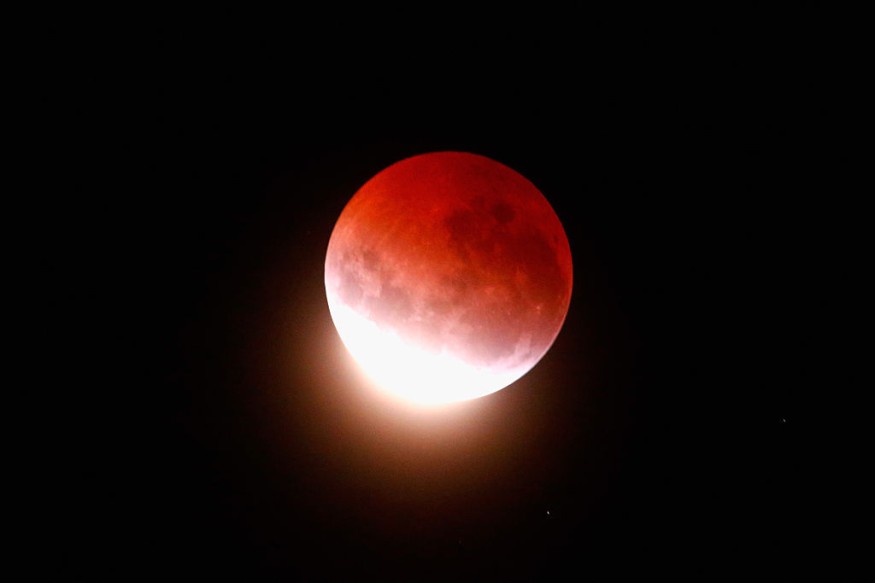The full moon will be plunged into the blood-red glow thrown by Earth's shadow on Thursday night, giving viewers a near-total lunar eclipse. Except for eastern Greenland, the display will be visible from North America - including the Lower 48, Alaska, Hawaii - and parts of South America and Russia.
Though it isn't a total lunar eclipse, it is the closest one can get to seeing totality without actually being there. The umbra, or the deepest area of Earth's shadow, will cover 97 percent of the moon at its height. Only a little slice of the moon's bottom left will be illuminated.

According to Space.com, the duration of Thursday night's eclipse - 3 hours, 28 minutes, and 24 seconds - will be a highlight since it will be the longest partial eclipse in 580 years.
The moon will be full at the time of the eclipse. According to NASA, some people call the November full moon the "beaver moon," a moniker given by Native Americans when beavers were very active in preparation for winter and it was time to build traps. NASA said for the cold conditions that begin at this time of year, the November full moon is also known as the frost, frosty, or snow moon.
When to Watch Beaver Moon Lunar Eclipse Depending on Time Zone
According to NASA, the penumbral eclipse will begin at 1:02 a.m. EST, assuming you can view the whole eclipse. The partial eclipse will begin around 2:18 a.m. EST, when the moon enters the umbra, or darker region of the Earth's shadow.
The moon, Space.com said, may turn a dark red or reddish-brown tint during the maximum eclipse around 4:02 a.m. ET. This is due to light refraction around the Earth's borders, which falls on the moon's face. Another way to look at it is that you're witnessing sunrises and sunsets reflected on the lunar surface.
When the moon passes out of the umbra at 5:47 a.m. ET, the partial eclipse will be over. At 7:03 a.m. ET, the penumbral eclipse will be complete.
| Event | PST | MST | CST | EST |
| Moon enters penumbra | 10:02 p.m. | 11:02 p.m. | 12:02 p.m. | 1:02 a.m. |
| Moon enters umbra | 11:18 p.m. | 12:18 a.m. | 1:18 a.m. | 2:18 a.m. |
| Maximum eclipse | 1:02 a.m. | 2:02 a.m. | 3:02 a.m. | 4:02 a.m. |
| Moon leaves umbra | 2:47 p.m. | 3:47 a.m. | 4:47 a.m. | 5:47 a.m. |
| Moon leaves penumbra | 4:03 p.m. | 5:03 a.m. | 6:03 a.m. | 7:03 a.m. |
Most of North and Central America and Asia's far east can see the complete eclipse. The eclipse will only be seen in the far eastern parts of the Americas before the moon departs the umbral phase.
Most of the eclipses will be seen in South America before the moon sets. At the beginning of the eclipse, Europe and western Africa will view some of it; a moonrise eclipse will enable partial sight in central Asia, the southern Pacific, and Australia.
How to Watch Online
Suppose you're clouded out or too chilly. In that case, you may view an ultra-long lunar eclipse online on Friday (Nov. 19) from one of the numerous websites.
Astronomical Society of South Australia
The Astronomical Society of South Australia will stream live on YouTube or Facebook at 7 p.m. local time (4:30 a.m. ET).
"Our network of imaging telescopes located in South Australia, Victoria and Queensland, and further away if necessary, will provide the best opportunity to view this special celestial event regardless of local weather conditions," the society stated on its event page.
Griffith Observatory
Weather permitting, the Griffith Observatory in Los Angeles will post a timelapse video of the eclipse on its YouTube channel. The timelapse will begin at 9 a.m. EST, with an online broadcast starting at 1 a.m. EST on Friday, Nov. 19.
The park will be closed during the eclipse due to the pandemic, according to the observatory.
Time and Date
At 1 a.m. ET, Time and Date will begin its webcast on YouTube.
Time and Date claimed in the video description that their live broadcast is the "ideal companion" to this eclipse for stargazers, whether or not it is visible from your location.
Virtual Telescope Project
Starting at 2 a.m. ET, the Virtual Telescope Project will stream live from Rome.
"As in the past, the Virtual Telescope Project will partner with some great astro-imagers from all around the planet to bring to you the stunning beauty of such a precious event," the organization said on the event page.
RELATED ARTICLE : Partial Lunar Eclipse: When, Where, How You Can See the Different Phases Of Moon Occurrence on November 19
Check out more news and information on Space in Science Times.











